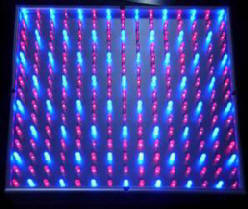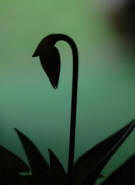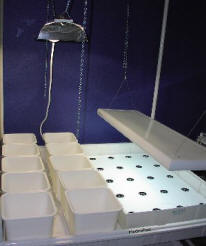This post may contain affiliate links. That means if you click and buy, I may receive a small commission. Please read my full disclosure policy for details.
INDOOR GROW LIGHTS
For Your Hydroponic Garden

Indoor grow lights are now so advanced they are actually close to sunlight in the spectrum they provide. You can grow vegetables in a dark basement! Learn about these amazing lights here.
Most everyone has successfully grown
houseplants indoors without special lighting. House lamps and window
lighting is plenty for schefflera or spider plants; but it's not enough
to produce tomatoes and squash.
You'll need to provide your
hydroponics food factory with decent lighting. Vegetable production
requires very bright light which contains the correct type (spectrum) of
light, or they won't flower and fruit. This can be provided either by
sunlight, by special HID lights (high intensity discharge), or latest generation multiband LEDS.
 |
 |
In an outdoor garden, vegetable plants
require 4-6 hours of direct sun, with 8-10 more hours of bright indirect
natural light each day. Indoors, you can almost duplicate this with special (and fairly expensive) HID or LED lamps, set on timers to run 14-16 hours per day.
As
with temperature, more is not better when it comes to lighting your
garden. You might think that keeping the lights on 20 or even 24 hours a
day would encourage better or faster growth. Not!
During
the day, plants use the light and heat to manufacture their energy. At
night, when the lights go off and they cool down , they assimilate and
grow. Plants need to rest and recoup at night, just like you do, or they
quickly become exhausted and die.
So stick to the lighting routine
recommended above and you'll do well.

Taking a snooze
TYPES OF INDOOR GROW LIGHTS
Technology has advanced... and so have grow lights. There is now an improved fluorescent light, the T5,
which does a great job with lettuce, leafy vegetables and herbs. But it just doesn't have the right spectrum to induce fruiting type veggies, like tomatoes,
beans, melons and squash. If you want to stay strictly with the
lettuces and herbs, then get a T5 fluorescent unit.
But
if you think you might want to grow fruiting crops too, then go with an
HID or quality LED, as it will work for both leafy and fruiting veggies. Or do like I did, get one of each and do
a "split garden". A very versatile setup...

HID & T5 fluorescents
Now, to further complicate matters; there are two types of HID lights: HPS and MH... but not to worry, we told you we'd keep this simple for you, right?
Follow our quick and concise guide to indoor grow lights here: LIGHTING SYSTEMS.
Return From Indoor Grow Lights to Climate
RETURN TO THE HOME PAGE
New! Comments
Have your say about what you just read! Leave me a comment in the box below.

Reply